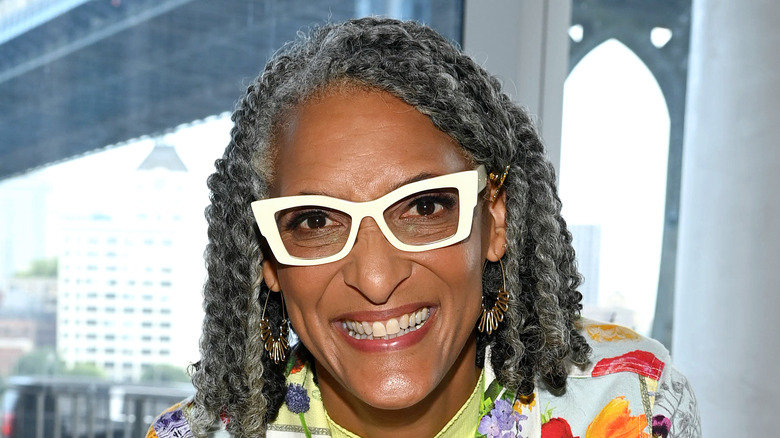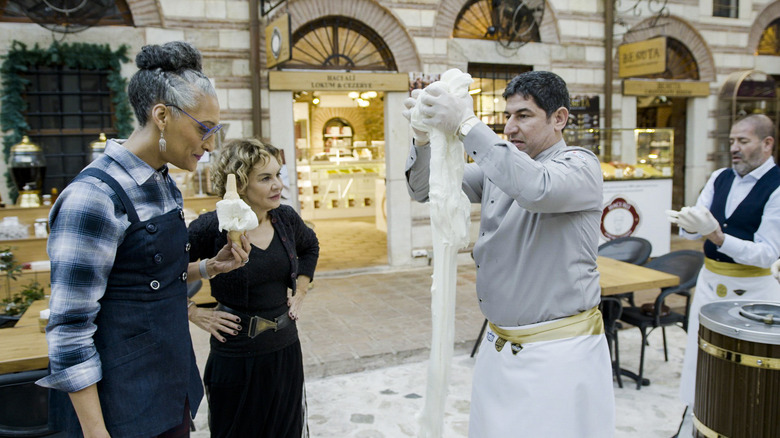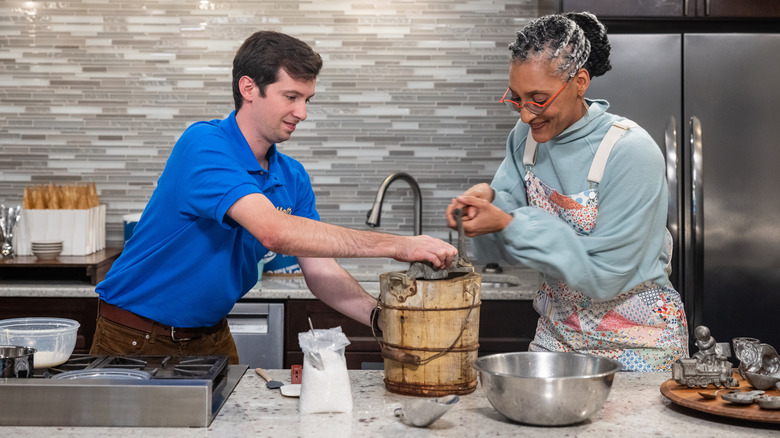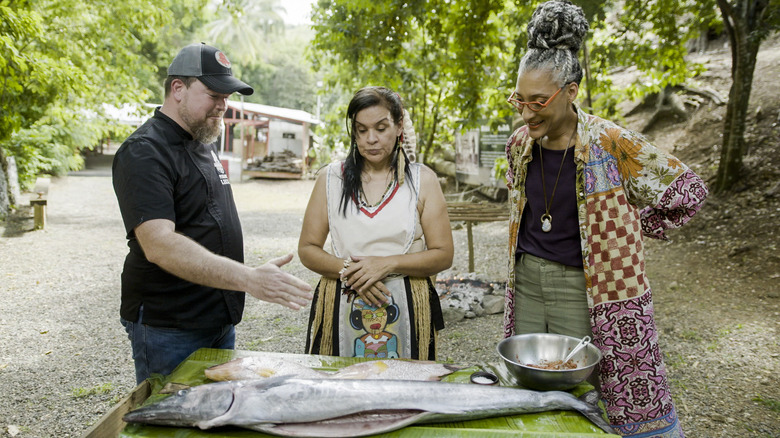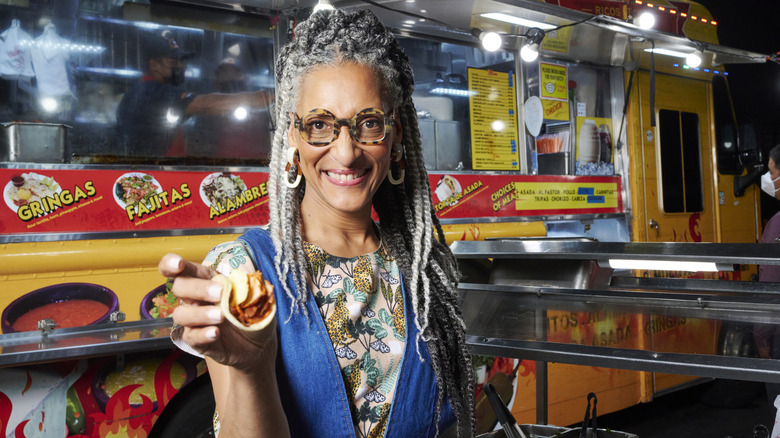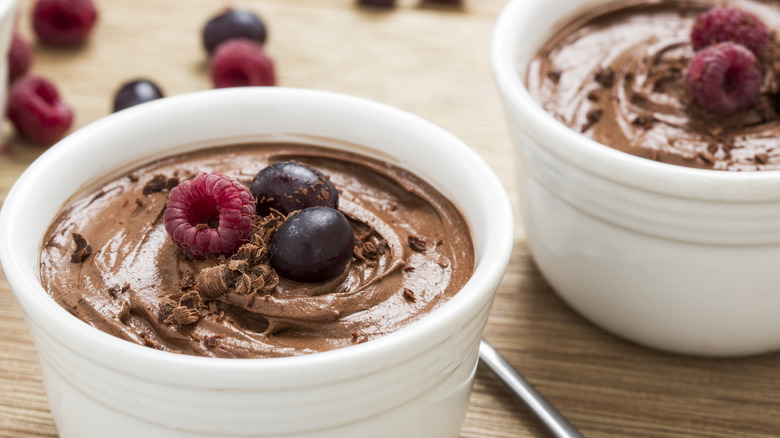What Carla Hall Discovered About The Origins Of Popular Dishes On Chasing Flavor - Exclusive Interview
Carla Hall might be well known for her previous roles as a lovable "Top Chef" contestant and co-host of "The Chew," among others. Her latest show, "Chasing Flavor" follows Hall as she travels around the world in search of the origins of America's favorite foods. The six-episode show on Max features popular bites like ice cream and tacos, spanning the globe to places as far as Turkey and Ghana, as well as various cities across the country.
In each episode, Hall hops around from one place to another, unearthing more and more about the history of these classic dishes. It's rarely straightforward, and her discoveries send her to a multitude of stops where she meets people deeply entrenched in the stories of each dish. Forget the white tablecloths and gourmet meals — Hall goes to the heart of the action. Apart from the culinary wonders she tastes along the way, viewers get to experience international travel in a new light. Tasting Table got on a call with Carla Hall to chat about her upcoming show and what she learned along the journey.
The muddy origins of America's favorite frozen treat
I had the pleasure to watch the ice cream episode of "Chasing Flavor" and it was really great!
I'm so glad. I'm so proud of that show. I love it so much. So thank you. Did it make you want ice cream afterwards?
Oh yes, definitely! From the different styles that you looked at on the show — the American style, French custard, gelato, and Turkish dondurma — have you adopted any of these styles yourself in the kitchen?
Honestly, one of the ingredients that I am just amazed about because I didn't know it, is salep [used to make Turkish ice cream]. And not only using salep in ice cream, but also using it as a hot drink in the winter because that's where it started. So it's like the boiled custard versus ice cream and I am just fascinated by it.
And the other thing which I didn't really think about was the American ice cream, to egg or not to egg. I mean I worked at Baskin-Robbins and we had the French custard, like the French vanilla ice cream, and it was yellow. I never thought about it [containing egg yolk]. And for Philadelphia-style ice cream to become American-style ice cream. I was like, "Wow, it's amazing."
But what hit me, and we see it a couple times that will happen along the various journeys — something that was started in one place, as soon as it catches on, it loses one name and it gains another that is more ubiquitous. Then it uses that name and then becomes something else. And so why I think this show is so important is it connects those dots and all the things that you'd forgotten. It's sort of reminding people that all these different cultures had a hand in this dish as we know it.
What did you conclude about the origins of American ice cream and the other popular dishes you explored?
Even then it comes from something, I mean, as an African-American, as a Black woman, I'm like, "Wow." It's part of my history, and I was happy to tell that story about Augustus Jackson. And also the role that, and the influence, that the presidents played in our food history and training their "chefs," even though they were enslaved, but it's become part of the fabric of who we are.
And I feel like you really can't separate the culture from the food. And so that's amazing. I mean, every time I learn something about my culture that is not mainstream, I get excited because it makes me feel proud. It makes me feel like, "Wow, if this then something else, and what else have we done?" And everybody wants to feel seen, regardless of where you're from.
High-quality ice cream makes all the difference
Do you have a favorite ice cream brand or scoop shop in the U.S?
I'm partial to Jeni's. I love Jeni's.
Any flavor?
I love her. I love the lemon. Is it the lemon blackberry? Or the lemon? And there's another one that's local here [in D.C.], that's Moorenko's. So that's where I go. I used to share a kitchen with them when I was catering. That's a local brand that I like where I learned about the slow churn of ice cream. I mean, Susan Soorenko the owner, she was the one who basically upped my game in ice cream. Just learning from her and the difference between the overrun and all of that. So she's the reason I can appreciate expensive ice cream. Because I will pay for good ice cream.
It was cool to watch you in the Philly shop with the bicycle churning machine they had set up.
Oh my God. Where the seat was too low, where my knees were in my chin. It was so much fun. So I got to do mix-ins, and they're like, "What do you want to put in your mix-in?" And I was like, "Well, I love lemon." So I did the lemon shortbread and I did pistachios, and then I did a caramel swirl. And they're like, "I think this is too much." And then when the guy had it, he's like, "Oh, this is really good." I'm like, "See? I know stuff."
It was so good. I mean, being there and eating the ice cream off the line was just an amazing experience. And it's something that I know how special it is to be able to get a cup of your ice cream off the line when it's still soft.
In Florence too, the machine you used to make gelato.
Oh my gosh, that, I almost lost my mind. It was so delicious, that sweet cream.
You could see it in the little pots she served it — the way it just sort of fell swooped over so delicate and soft and creamy.
You're taking me back there. There's so many of those moments when I look at the pictures and I'm reliving them. I'm like, "Oh yeah, I remember that." And we're about the same age, Silvana. She has a place in Disney Springs; there's a Vivoli in Disney Springs. And she was saying that their crema didn't sell well. So I said, "Oh, are you selling the crema?" And she's like, "It didn't sell well." And I said, "You know why? Because in the States we call it sweet cream, so you need to give it a different name."
Chasing Flavor demonstrates the multifaceted nature of food history
Throughout your filming, what was the most unexpected cultural influence that you realized played a role in one of these American dishes?
I mean the al pastor. And I think for that one, what was so amazing about that — because I'm from Tennessee and if I was going to have a taco, it's going to be a hard taco. I grew up on hard taco — but to see that culture and the vertical spit ... You have a group of people fleeing from religious persecution and going from the Middle East to Mexico, and then saying, "Oh, let's save space" and then creating the vertical spit. I mean, all of that is just fascinating. And it's how necessity is the mother of invention.
So this story for me, I felt like everything about it was new, even though I've had al pastor maybe, somewhere. I was just wowed by even tacos negro and how that's only 60 years old and how it's influencing people.
And so you're welcoming other voices that change the food even now. So I was just amazed. And I tell you, and even though I haven't done it, I'm like, "How do I build a vertical spit?" And I have looked it up online, I'm trying to figure it out. With all my products, I'm like, "Can we do a vertical spit?" It just makes so much sense. I want to figure it out because you can do whatever. You don't have to do al pastor, you just have marinated meat and onions and I loved it.
Well, that's exciting. That might be a new technique you'll expand upon.
Look for it. I'm going to do it.
The origins of popular dishes aren't always what you see
Did you have any previous beliefs about a particular cuisine or ingredient that was altered during the filming?
Barbecue. Barbecue was personal, and I knew the stories of the role that Black people played. When we first looked at this story ... we were going to a place in Memphis, and it was a place that's been around many years ... It was a German guy. And I was like, "What? Wait." And I was just incredulous. I'm like, "How is this not a Black business?" But then when I learned more, the chine or the ribs were used to stuff in the barrels where they have the pork, to keep it from knocking around, and filler basically.
In order to have the ribs, you needed to have refrigeration, you needed to have a lot of space. And so if you didn't have the means to have that space or to have refrigeration, you were all doing your ribs sort of on small scale, one hog. So I understand that ribs came from maybe someone with means, but it was taken from someone who was making it at home. And those were the people who were cooking it. But see, you didn't see those people. You only saw the people who had the means to have the restaurant, who had the refrigeration ... So it was hard, I think, for me to see it because it's a little bit of erasure. So we decided not to show that restaurant because it didn't really honor, I think the people who were in the kitchen.
And I think even now, when we were in South Carolina, was it? We were in Virginia and the whole hog cooking was about, "Who is giving the big parties?" It was people in politics. This is how they campaigned. Who created the pit? It was the indigenous people. Who was doing the spices? It was Black people. So what I saw was it's many hands, everyone had a part to play. And it's about not just showing the people who gave the party, but all the other people, all of the supporting cast. So I loved it for that. I mean, it literally sort of shone a light on why this show is important.
Did you discover a favorite restaurant for al pastor?
I did, Tacos Árabes Bagdad, the brothers in Puebla, Mexico. It was so beautiful. Oh my gosh. And just having their thin pita, which became the tortilla ... And then the dishes that you eat it on, they gave me a set. And it was just so beautiful. Everything came out of necessity. And then I think we can ask ourselves, what dish did we create even at home out of necessity because you didn't have an ingredient?
Yes, often the best ones. And dondurma — were you able to find the key ingredient, salep?
I haven't found it. I called a friend and I said, can you make dondurma? Can I get this recipe? And she makes ice cream, and they used to make it for a restaurant, but the restaurant isn't around anymore. I'm still looking. I hope everyone floods my inbox and social media ...
Making classic recipes with reimagined twists
What would you create as a perfect Valentine's Day luxury Sunday for two?
Oh, I love a Sunday supper ... I would do an English Sunday roast. So I would have the Yorkshire pudding, and I would do different flavors. I wouldn't do the beef because my husband can't do beef, but I would do pork instead, like a porchetta with herb rub ... And then the beautiful potatoes that are cooked in stock. My grandmother used to make potatoes and green beans cooked in stock, so then I would do that and then take the potatoes out and roast those ... And then I would have biscuits and then gravy. And it's so heavy.
No dessert?
You know what I would do for dessert? I'm not a chocolate person, but I love chocolate malt. I would do a chocolate malt mousse with just a light drizzle of a chocolate sauce with berries on the side.
Any other special desserts?
Oh, for me it would be my grandmother's pound cake. It would be my grandmother's pound cake, hands down. And then, because I love clotted cream and just poured cream, I would do a brown sugar sour cream to go over it. So it's kind of tangy, balancing out the sweet, but a little molasses, a little bit of that.
That sounds very nice. Do you have any party dishes for the upcoming Super Bowl that you like to make?
Well, right now, because I will be there at the Taste of the NFL, I created a dish with Doritos ... It's croquettes, so ham and cheese croquettes with Doritos. So I am doing them with the cream and thickening the cream and ham and some cheese in there, but infusing the cream with the Doritos and then coating them with crushed-up Doritos and frying them. I'm so excited. And then I'm making them in triangles because Doritos are triangular.
You can catch Carla Hall on "Chasing Flavor" which is available to stream on Max as of February 1.
This interview has been edited for clarity.
